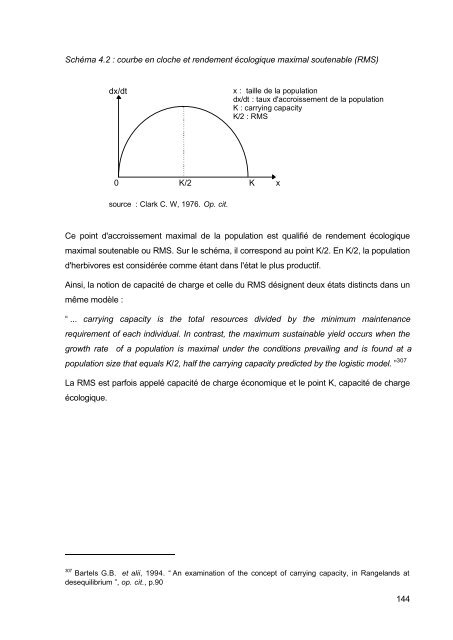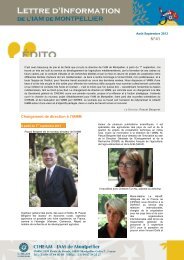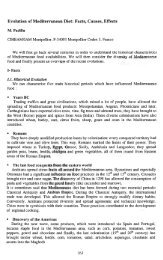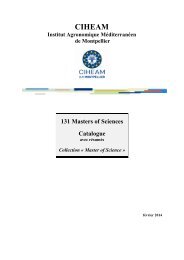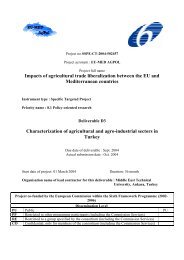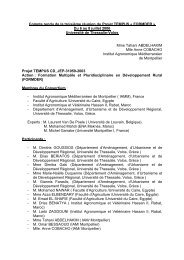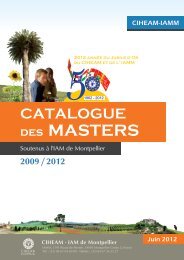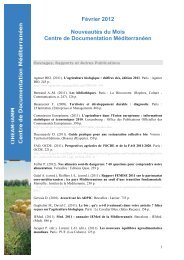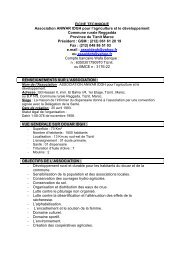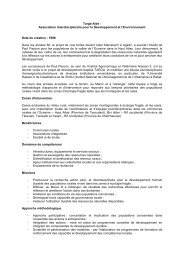- Page 2 and 3:
LISTE DES SIGLES UTILISESBPL : bien
- Page 4 and 5:
jaoro ou jawuro : chef de quartierj
- Page 6 and 7:
INTRODUCTION GENERALE“ Un nomade
- Page 8 and 9:
l’alimentation des troupeaux pend
- Page 10 and 11:
La problématique de la recherche p
- Page 12 and 13:
économie institutionnelle comme ce
- Page 14 and 15:
PREMIERE PARTIE : L’ELEVAGE, LA T
- Page 16 and 17:
consiste à examiner les modèles d
- Page 18 and 19:
l’affaiblissement et à la désor
- Page 20 and 21:
Section 1 - L'élevage à l'Extrêm
- Page 22 and 23:
Waza-Pouss ; au nord de cette ligne
- Page 24 and 25:
La région de l'Extrême-Nord prés
- Page 26 and 27:
L'élevage des petits ruminants est
- Page 28 and 29:
La présentation des activités rur
- Page 30 and 31:
source : Mohammadou E., 1988. Op. c
- Page 32 and 33:
Les sécheresses de 1969-74 provoqu
- Page 34 and 35:
Nous les appelons des pasteurs itin
- Page 36 and 37:
saison sèche. En 1976, une étude
- Page 38 and 39:
Dans les deux régions, l'évolutio
- Page 40 and 41:
2. 2 - Commerces et déplacements d
- Page 42 and 43:
2. 2. 2 - La réglementation des pi
- Page 44 and 45:
CHAPITRE II - EVOLUTIONS DANS LES P
- Page 46 and 47:
éléments de ce système politique
- Page 48 and 49:
« ...la charge est presque partout
- Page 50 and 51:
1. 2 - Objectifs de l'étude et mé
- Page 52 and 53:
Dans ces questionnaires statistique
- Page 54 and 55:
capacité pour chaque concession à
- Page 56 and 57:
troupeaux, en promouvant l'usage de
- Page 58 and 59:
C'est la variable muskwari qui donn
- Page 60 and 61:
2. 2 - L'essor de la complémentati
- Page 62 and 63:
Encadré 2.1 : les circuits du tour
- Page 64 and 65:
2. 2. 2 - Un phénomène récent :
- Page 66 and 67:
marchande des complémentarités en
- Page 68 and 69:
l'installation du projet en 1979, l
- Page 70 and 71:
même agro-éleveurs sont nettement
- Page 72 and 73:
Tableau 2.8 : les différentes taxe
- Page 74 and 75:
Pour pouvoir comparer les coûts de
- Page 76 and 77:
troupeau, confirment l’avantage
- Page 78 and 79:
des troupeaux encore transhumants v
- Page 80 and 81:
yayre, celui des chefs kotoko. Il d
- Page 82 and 83:
3. 2. 3 - Conclusion : la pratique
- Page 84 and 85:
Cette chute des effectifs est suivi
- Page 86 and 87:
importants. Le bloc I est élargi e
- Page 88 and 89:
4. 1. 2. c - ConclusionL’incertit
- Page 90 and 91:
Les éleveurs sédentaires, les agr
- Page 92 and 93:
4. 2. 2. b - L'impact d'autres acti
- Page 94 and 95: CHAPITRE III - MOBILITES ET SEDENTA
- Page 96 and 97: culturelle. La sédentarisation dé
- Page 98 and 99: 1. 1. 1. b - L'arrivée au Cameroun
- Page 100 and 101: A cette époque, les groupes arabes
- Page 102 and 103: 1. 2 - Pastoralisme et sédentarisa
- Page 104 and 105: appauvrissement des pasteurs dû au
- Page 106 and 107: commerçant en bétail shuwa. Les c
- Page 108 and 109: 2. 1. 1 - Le lignage maximalLes pas
- Page 110 and 111: Cette notion de lignage primaire et
- Page 112 and 113: 2. 2 - L'arrivée et la composition
- Page 114 and 115: arrivés en catastrophe. Certains s
- Page 116 and 117: Encadré 3.4 : les Kesi de Kolara,
- Page 118 and 119: Encadré 3.5 : deux « arrangements
- Page 120 and 121: 3. 1. 1. a - Waalde et wuro, deux n
- Page 122 and 123: 3. 1. 1. b - Le wuro et le dudal ch
- Page 124 and 125: Tableau 3.2: nombre d'étapes par i
- Page 126 and 127: empruntés par le bétail qui suit
- Page 128 and 129: jaawol : au début de la saison fro
- Page 130 and 131: écoltés. Pour atteindre l'entrée
- Page 132 and 133: 3. 2. 2. b - L'intervention des aut
- Page 134 and 135: Logomatya. La permanence du pastora
- Page 136 and 137: demeure importante à l’échelle
- Page 138 and 139: et l’examen de plusieurs études
- Page 140 and 141: Section 1 - Capacité de charge et
- Page 142 and 143: Dans le cas des pâturages et des t
- Page 146 and 147: 1. 2 - Portée et limites de l'appr
- Page 148 and 149: - celle de la capacité de charge
- Page 150 and 151: 1. 2. 2. b - La prise en compte de
- Page 152 and 153: Section 2 - L'usage bio-économique
- Page 154 and 155: La condition de production répond
- Page 156 and 157: modèle, la production issue de l'e
- Page 158 and 159: - l'entrée de nouveaux agents sur
- Page 160 and 161: Le modèle d'équilibre représente
- Page 162 and 163: 2. 2. 4. Conclusion : pour en reven
- Page 164 and 165: “ Chaque individu contribue volon
- Page 166 and 167: “ How do real-world clubs operate
- Page 168 and 169: 3. 2. 1. b - Le patrimoine, un bien
- Page 170 and 171: 3. 2. 2. b - La notion de patrimoin
- Page 172 and 173: CHAPITRE V - ECHANGES HORS MARCHE E
- Page 174 and 175: moitié du XVème siècle et au dé
- Page 176 and 177: 1. 1. 2 - La terre et la rente fonc
- Page 178 and 179: “ C'est la baisse du taux de prof
- Page 180 and 181: “ La quasi-rente, [est] conçue c
- Page 182 and 183: Si l’excédent de produit qui for
- Page 184 and 185: écologique des pâturages sahélie
- Page 186 and 187: 2. 1. 1. c - Illustration : le rég
- Page 188 and 189: 2. 1. 2 - L'usage économique des p
- Page 190 and 191: - le nombre de tours est fini et co
- Page 192 and 193: si x animaux sont rajoutés au-del
- Page 194 and 195:
“ Dans le dilemme du prisonnier,
- Page 196 and 197:
Section 3 - Outils conceptuels d'in
- Page 198 and 199:
3. 1. 2 - La prise en compte de l'h
- Page 200 and 201:
coûts est devenu insupportable, la
- Page 202 and 203:
3. 3 - L'accès aux pâturages : pr
- Page 204 and 205:
3. 3. 1. c - Conclusion : hypothès
- Page 206 and 207:
Les modèles multi-agents (SMA) son
- Page 208 and 209:
Conclusion de la sous-partie 2Les p
- Page 210 and 211:
Conclusion de la partie IIl y a au
- Page 212 and 213:
et :“ The study of the peasant ec
- Page 214 and 215:
Introduction de la partie IIL’ét
- Page 216 and 217:
Sous-partie 3 - JuMel, ou la collab
- Page 218 and 219:
Dans JuMel, c’est le jeu des coû
- Page 220 and 221:
Section 1 - L’outil SMA et ses us
- Page 222 and 223:
Ces structures stables et inattendu
- Page 224 and 225:
1. 1. 2. b - Actions et interaction
- Page 226 and 227:
Un second modèle, Shadoc, étudie
- Page 228 and 229:
1. 2. 2 - Le SMA, une articulation
- Page 230 and 231:
1. 1. 3. c - ConclusionLes expérie
- Page 232 and 233:
La problématique de JuMel articule
- Page 234 and 235:
“ En savanes, le bétail contribu
- Page 236 and 237:
Ces hypothèses ont des conséquenc
- Page 238 and 239:
1. 3. 2. b - Le déroulement d'un t
- Page 240 and 241:
1. 3. 4. - Conclusion1. 3. 4. a - m
- Page 242 and 243:
contractualisation et les règles i
- Page 244 and 245:
Les conditions proposées par Ostro
- Page 246 and 247:
2. 1. 1. c - ConclusionLa structure
- Page 248 and 249:
La conception des coûts d'accès d
- Page 250 and 251:
La dimension cognitive des agents
- Page 252 and 253:
2. 3. 4 - ConclusionLe point de dé
- Page 254 and 255:
2. 2. 1. a - De l'appropriation de
- Page 256 and 257:
2. 2. 2 - L'apport méthodologique
- Page 258 and 259:
Cette réciprocité renvoie à la n
- Page 260 and 261:
2. 2. 3 - L’étude de l’économ
- Page 262 and 263:
ConclusionLe SMA est un outil de l'
- Page 264 and 265:
CHAPITRE VII - JUMEL, UN MODELE D
- Page 266 and 267:
1. 1. 1 - La dynamique des contrats
- Page 268 and 269:
Encadré 7.2 : la négociation des
- Page 270 and 271:
ne débouche pas forcément sur une
- Page 272 and 273:
se fait par l'établissement d'une
- Page 274 and 275:
appartiennent pas à titre privé.
- Page 276 and 277:
- la régularité des relations dan
- Page 278 and 279:
occupation excessive des pâturages
- Page 280 and 281:
Dans les simulation moindre coût,
- Page 282 and 283:
Tableau 7.3 : résultats des princi
- Page 284 and 285:
1. 2. 2. d - Récapitulatif des pri
- Page 286 and 287:
2. 1. 1. a - Des liens entre le typ
- Page 288 and 289:
- Dans les simulations à priorité
- Page 290 and 291:
constantes ou routinières avec que
- Page 292 and 293:
acquire knowledge and learning, to
- Page 294 and 295:
2. 1. 2. b - Pas de changement inst
- Page 296 and 297:
endent dans trois villages à chaqu
- Page 298 and 299:
2. 3. 1. a - Des individus économi
- Page 300 and 301:
2. 3. 2. a - Des interactions déce
- Page 302 and 303:
2. 3. 3 - La notion de représentat
- Page 304 and 305:
ConclusionDans le cas des échanges
- Page 306:
pour les ressources communes quand
- Page 309 and 310:
susceptibles de varier d’une coll
- Page 311 and 312:
Section 1 - Les conditions précolo
- Page 313 and 314:
jangali ainsi que des droits de pâ
- Page 315 and 316:
début du XXème siècle. Dans ce r
- Page 317 and 318:
esoin de chevaux (...) Cela corresp
- Page 319 and 320:
Tableau 8.2 : comparaison des princ
- Page 321 and 322:
"Les Peul de brousse constituaient
- Page 323 and 324:
les Grassfields et pour le Nigéria
- Page 325 and 326:
inoccupées depuis plus de dix ans.
- Page 327 and 328:
1. 3. 2. b - Conclusion : l'abandon
- Page 329 and 330:
Encadré 8.1 : création et modific
- Page 331 and 332:
- De recouvrer les impôts et taxes
- Page 333 and 334:
is of fiscal origin. Among fiscal r
- Page 335 and 336:
- mais au plan fiscal, la pratique
- Page 337 and 338:
Dans la région de Mindif, l'impôt
- Page 339 and 340:
Une taxe sur le droit de pâture de
- Page 341 and 342:
ConclusionL’étude des données c
- Page 343 and 344:
obtenus indiquent qu'il existe une
- Page 345 and 346:
Pour 85% des éleveurs de l'échant
- Page 347 and 348:
Le tableau 9.2 ci-dessous qui crois
- Page 349 and 350:
Le troupeau est l’assiette la plu
- Page 351 and 352:
1. 1. 3 - Conclusion : quel sens do
- Page 353 and 354:
1. 1. 3. b - Le garama à l’éche
- Page 355 and 356:
1. 2. 2 - Le montant des prélèvem
- Page 357 and 358:
laquelle est constatée l'existence
- Page 359 and 360:
1. 2. 4 - Les facteurs institutionn
- Page 361 and 362:
1. 2. 5. b - Comment prendre en com
- Page 363 and 364:
Encadré 9.4 : les montants de pré
- Page 365 and 366:
Encadré 9.5 : évolution des chefs
- Page 367 and 368:
Elles bénéficient généralement
- Page 369 and 370:
Les femmes des campements, lorsqu
- Page 371 and 372:
Pour l’étude des économies prim
- Page 373 and 374:
2. 2. 1. c - Jeu de l'offre et de l
- Page 375 and 376:
2. 2. 2 - Application de l’analys
- Page 377 and 378:
démarche qui ne laisse aucune pris
- Page 379 and 380:
ConclusionA partir des résultats d
- Page 381 and 382:
CHAPITRE X - RECIPROCITE ET CONFIAN
- Page 383 and 384:
Section 1 - Confiage et gardiennage
- Page 385 and 386:
mensuels monétaires sont proches e
- Page 387 and 388:
Dans les contrats de travail observ
- Page 389 and 390:
pas au hasard : il doit être recom
- Page 391 and 392:
Les risques encourus par le propri
- Page 393 and 394:
1. 2. 3 - Le confiage, un contrat d
- Page 395 and 396:
1. 2. 4 - Conclusions sur les contr
- Page 397 and 398:
Section 2 - Confiance et réciproci
- Page 399 and 400:
entretient symboliquement l'entente
- Page 401 and 402:
2. 1. 3 - La confiance, un mode sp
- Page 403 and 404:
2. 2 - Discussion : accès, contrat
- Page 405 and 406:
l’organisation des échanges, sur
- Page 407 and 408:
2. 3 - Vers une autre approche de l
- Page 409 and 410:
Le groupe actuel pastoral et solida
- Page 411 and 412:
Le prêt de bétail ou habbanae con
- Page 413 and 414:
ConclusionL'étude menée sur les b
- Page 415 and 416:
due à un aménagement des règles
- Page 417 and 418:
Conclusion de la partie IIDans le m
- Page 419 and 420:
La possibilité de tels échanges e
- Page 421 and 422:
églementation, de leur organisatio
- Page 423 and 424:
Les contrats d’accès aux pâtura
- Page 425 and 426:
communs que le principe de minimisa
- Page 427 and 428:
BIBLIOGRAPHIE CITEEABBADIE L., LEPA
- Page 429 and 430:
BAYART J-F, 1989. L’Etat en Afriq
- Page 431 and 432:
BOUSQUET F., BARRETEAU O., LEPAGE C
- Page 433 and 434:
CHICHE J.ET ALII, 1991. « L'appré
- Page 435 and 436:
DUPIRE M., 1962. « Des nomades et
- Page 437 and 438:
GODELIER M., 1974. « Considératio
- Page 439 and 440:
LANDAIS E., LHOSTE P., 1990. « L
- Page 441 and 442:
MOHAMMADOU E.., 1976. L'histoire de
- Page 443 and 444:
POLANYI K., 1991. La Grande Transfo
- Page 445 and 446:
SCHLAGER E. ET OSTROM E., 1992. “
- Page 447 and 448:
TURNER M.D., 1999. « The role of s
- Page 449 and 450:
Tableau 4.1 : une classification de
- Page 451 and 452:
LISTE DES ENCADRESEncadré 1.1 : la
- Page 453 and 454:
LISTE DES SCHEMASSchéma 2.1 : deux
- Page 455 and 456:
Section 2 - Complémentarités natu
- Page 457 and 458:
4. 1 - Le pastoralisme et le projet
- Page 459 and 460:
1. 1. 2 - Capacité de charge et re
- Page 461 and 462:
2. 1. 1. b - Une définition juridi
- Page 463 and 464:
1. 3. 4. a - modéliser des routine
- Page 465 and 466:
2. 3. 3. b - Les représentations d
- Page 467 and 468:
1. 1. 3 - Conclusion : quel sens do
- Page 469 and 470:
1. 2. 4 - Conclusions sur les contr
- Page 471:
ANNEXESAnnexe 1 : Les figures et le
- Page 474 and 475:
ANNEXE 1 : FIGURES ET CARTES DE LOC
- Page 476 and 477:
Figure 1 : La région de l’extrê
- Page 478 and 479:
Figure 3 : Les principales ethnies
- Page 480 and 481:
Figure 5 : Les structures administr
- Page 482 and 483:
Détails chefferiesannexes / 10
- Page 484 and 485:
Figure 7 : les écosystèmes pastor
- Page 486 and 487:
Figure 10 : Les circuits de la tran
- Page 488 and 489:
Figure 12 : Territoire de Mindif à
- Page 490 and 491:
Figure 14 : La transhumance de sais
- Page 492 and 493:
Figure 16 : Le peuplement shuwa dan
- Page 494 and 495:
Figure 18 : L’itinéraire et les
- Page 496 and 497:
tentons d'évaluer la place occupé
- Page 498 and 499:
« Officiellement, ces institutions
- Page 500 and 501:
non pétrolier:32023043301329272762
- Page 502 and 503:
Tableau B.4 : évolution du PIB et
- Page 504 and 505:
Section 2 - Quelle place pour l'él
- Page 506 and 507:
Les politiques d'hydraulique pastor
- Page 508 and 509:
populations locales, et en particul
- Page 510 and 511:
La répartition des ressources natu
- Page 512 and 513:
la mobilité du bétail : le bétai
- Page 514 and 515:
2. 2. 4 - L’élevage, une richess
- Page 516 and 517:
GONNEVILLE DE, G. DAVIOU D., LETENN
- Page 518 and 519:
Schéma 1 : Le Cameroun en Afriquea
- Page 520 and 521:
de la crise pastorale récente, cet
- Page 522 and 523:
Tableau C.2 : densités humaine et
- Page 524 and 525:
1 - l’appropriation des pâturage
- Page 526 and 527:
1. 2 La description des pâturages
- Page 528 and 529:
2.2 - Détermination de la capacit
- Page 530 and 531:
3 - L’organisation du système de
- Page 532 and 533:
Dans chaque bloc, la formule de ges
- Page 534 and 535:
le plan le plus réalisable serait
- Page 536 and 537:
Des réunions sont tenues avec les
- Page 538 and 539:
ConclusionLe projet agropastoral de
- Page 540 and 541:
Tableau : les trois sites pastoraux
- Page 542 and 543:
usages alternatifsparticularités-
- Page 544 and 545:
SCHOLTE P., MORITZ M., KARI S.,1995
- Page 546 and 547:
ANNEXE 4 : ELEMENTS DE CHRONOLOGIE
- Page 548 and 549:
Au XIIIème siècle, la province du
- Page 550 and 551:
territoire se réduit. S'il parvien
- Page 552 and 553:
En 1819, les Peul s'installent à M
- Page 554 and 555:
A la guerre entre le Bornu et ses v
- Page 556 and 557:
Schéma 1 : Localisation des empire
- Page 558 and 559:
ANNEXE 5 - LES ENQUETESIntroduction
- Page 560 and 561:
dans la plupart des campements past
- Page 562 and 563:
121 Beauvilain A., 1989. Nord-Camer
- Page 564 and 565:
Tableau E.1 : effectifs en troupeau
- Page 566 and 567:
Pour les troupeaux sédentaires, c
- Page 568 and 569:
Kélé (Moulvoudaye) 1 2 3 6Kaya (M
- Page 570 and 571:
2 - salariée3 - autresi 2 ou 3, d
- Page 572 and 573:
achetez-vous des tiges?si oui, nomb
- Page 574 and 575:
3 : les deux4 : pas de rémunérati
- Page 576 and 577:
Q 35 IDENTITE IDTE vous pensez que
- Page 578 and 579:
sur l'histoire du troupeauQ 47 PERE
- Page 580 and 581:
tourteaux, tigesQ 67 TOURTEAU TOUR
- Page 582 and 583:
à propos de l'emboucheQ 95 EMBOUCH
- Page 584 and 585:
1. 2. 3 - Les objectifs du traiteme
- Page 586 and 587:
D’après les entretiens : « le b
- Page 588 and 589:
2. 1 - La mise en classe des troupe
- Page 590 and 591:
l’intégration des deux activité
- Page 592 and 593:
2. 2 - Les classes de troupeaux, le
- Page 594 and 595:
Tableau E.9 : classes de troupeaux
- Page 596 and 597:
2. 2. 1. c - Combinaison linéaire
- Page 598 and 599:
2. 3 - Achat de tourteaux et pratiq
- Page 600 and 601:
- 17 à commencer entre 1979 et 198
- Page 602 and 603:
2. 3. 2 - Organisation du fichier q
- Page 604 and 605:
Ces éléments nous incitent à pen
- Page 606 and 607:
KARAL73 individusmoyenne de 27090fc
- Page 608 and 609:
2. 3. 3. c - L’analyse factoriell
- Page 610 and 611:
2. 2 - Les entretiens et les observ
- Page 612 and 613:
arborescence :- agriculture : donn
- Page 614 and 615:
simultanément. Les taxes pastorale
- Page 616 and 617:
Schéma 2 : Localisation des zones
- Page 618 and 619:
Graphique 1 : La capacité de charg
- Page 620 and 621:
Graphique 3 : Les accords passés a
- Page 622 and 623:
Graphique 5 : Les accords passés a
- Page 624 and 625:
Graphique 7 : Résolution des contr
- Page 626 and 627:
annexes /154
- Page 628 and 629:
1. 2. 1 - La crise de 1986 à 1994.
- Page 630 and 631:
Annexe 5 - Les enquêtes ..........


